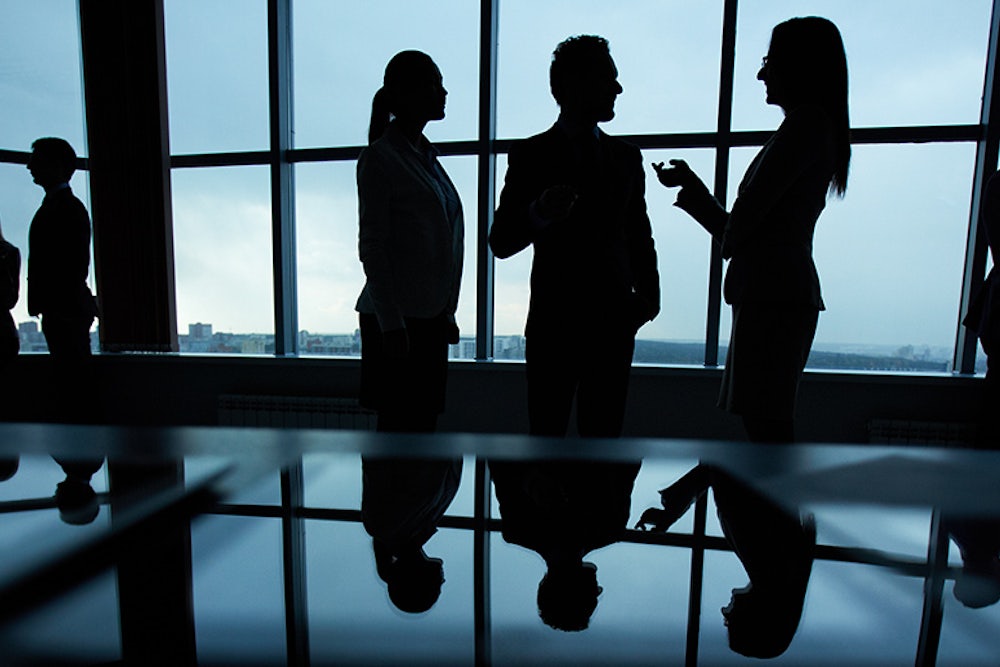Over the last few years, doctors have called sitting “the new smoking.” Studies have identified excessive sitting as a risk factor for obesity, cancer, and heart disease. And an infographic claiming sitting is deadly went viral. For hipsters and health nuts, sitting while you work is becoming practically taboo—but some daredevils maintain that the comfort factor offered by chairs outweighs the health risks. The New Republic’s Ben Crair, for one, has publicly admitted that he likes to sit, saying it feels “fantastic.” This month, The Onion reported on a new study suggesting people who sit for at least five hours a day are “significantly more likely to be comfy.”
In the anti-sitters’ latest salvo, researchers have shown that standing up may encourage more creative and collaborative group-work. Andrew Knight and Markus Baer, professors at the business school at Washington University in St. Louis, recruited 214 undergraduate students and broke them into groups of three to five. They assigned each group to work together for half an hour to write a script for a college recruitment video, which would be judged for creativity as well as execution. All groups worked in conference rooms equipped with a whiteboard, easels, and markers, but half the groups worked in a room with five office chairs and a table—a “sedentary workspace”—while the other half worked in a room empty of table or chairs. Knight and Baer, who describe their results in a new paper in the journal Social Psychological and Personality Science, hypothesized that the students in the chair-less room would feel less constricted and come up with more ideas. It turns out they didn’t see much of a difference in the end products, but the groups that worked in the unfurnished rooms showed higher signs of engagement and fewer signs of territoriality. Knight and Baer measured engagement by having participants wear wireless sensors that would monitor the activity of their sympathetic nervous system—known by psychologists to reflect arousal. The researchers judged how territorial participants felt over their own ideas by administering a survey after the experiment, having students rate statements like, “Everyone in my group was protective of his or her ideas.” “Our results suggest that if leaders aspire to enhance collaborative knowledge work, they might consider eschewing the traditional conference room setup of tables and chairs and, instead, clear an open space for people to collaborate with one another,” Knight and Baer conclude.
Being possessive over your own ideas is one of the least helpful things you can do when working with others. And if a simple change of furniture could make people more inclined to prioritize the group goal, it’s probably something companies should consider. (Not to mention the health risks of sitting, which are well-established. The most thorough review of the evidence—a 2012 paper in the journal Diabetologia that took into account 18 studies involving nearly 800,000 people—found that the people who spent the most time sitting have nearly twice as high a risk of heart disease and diabetes as those who sat the least, even if they exercise regularly.)
Knight and Baer aren't the only ones exploring the psychological effects of standing. Some business psychologists and lay people looking to boost their productivity are also jumping on the standing bandwagon. As part of an experiment for New York magazine, journalist Dan Kois spent an entire month on his feet (with exceptions for sleeping and defecating); he reported that he not only lost five pounds without trying but also cut his time-wasting “drastically,” getting more writing done than in any month he could remember. A Latvian start-up installed a standing desk in their office and had employees use an app to keep track of the amount of work they accomplished standing versus sitting; they concluded that standing up led to a 10 percent increase in productivity.
Considering the evidence, it's no surprise that more and more companies—from start-ups to large corporations like Google, Facebook, and AOL—are offering employees the option of using standing desks alongside traditional ones. Psychologists have shown that simply installing standing desks in an office is an effective way to get people to spend more of the day standing up. In an Australian experiment last year, a team of health researchers installed standing desks at a company in Sydney. Before they introduced the new desks, employees spent an average of 6.9 hours a day sitting at work; when the researchers checked back three months later, that number was down to 5.4.
Most of the research on standing and productivity is based on small sample sizes (or in cases like Dan Kois’s experiment, a sample size of one). Standing desks could be just a fad. But even if the benefits have yet to be proven, many workers are embracing them. Scott Eichinger, who works in an office at the University of Maryland, told The Washington Post that working at a standing desk miraculously cured his headaches, back pain, and fatigue. His colleague Renee Sicchitano loved her standing desk so much that co-workers noticed her jumping for joy. Changing your stance probably won’t make you love a job you hate—but given that the majority of us don’t like working in an office, anything that could make people less miserable about the prospect of spending all day in one is probably worth investigating.
Image via Shutterstock
